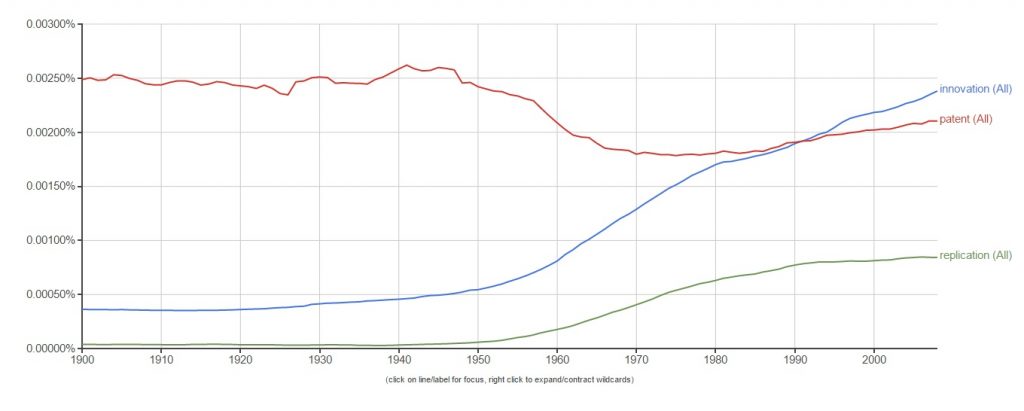Customers and stock markets develop their perception about the current and future products, which serves as a key input to decide the Most Innovative Companies. We see R&D function as the owner of innovations and technologies, which is limiting. For several years, innovations in products were around ‘product functionality/features’ and was owned by the R&D professionals. R&D scientists have been using patents to protect their outcomes from getting copied to maximize the value from their research. ‘Patents’ have been considered the most critical metric for R&D scientists. This created an impression that R&D drives innovations and many people started assuming patents and innovations to be synonyms.
Let’s look at the following trend. The Ngram shows that the number of books written on ‘Innovation’ were far less than the number of books written on ‘Patent’ in the first half of 20th century. Gradually the gap diminished and just before the beginning of 21st century, ‘Innovation’ outpaced ‘Patent’.

This chart indicates that the interest of people on innovation has either increased substantially but this hasn’t resulted in corresponding increase on the subject of Patent. No doubt, patents were/are used to avoid/delay the competitors to copy the technology (research outcomes) which enables many innovations.
Globally, the research capabilities have become more dispersed, deeper and narrower. As a result, the innovators need to have finesse to identify, acquire and integrate dispersed technologies to create a meaningful innovation. In the last 2-3 decades, we see increasing number of innovations that are not necessarily differentiated through patents but through customer centric designs.
Other than using patents to protect and avoid competitors copy innovations successfully, companies use following three methods to discourage competitors:
- Trade secrets and know-how
- Distribution strength, Network of partners, Customer (emotional) connect, the brand etc: These make it difficult for competitors to replicate the success from the product even it is copied technically. This can be achieved by the managers working in Sales, distribution, branding.
- Pace of innovations: This is achieved through fierce pace of innovations and at regular intervals. These innovations are a good mix of incremental and bigger innovations. Such fast paced innovations baffle & unnerve the competitors. This method is more relevant in today’s environment, which is overwhelmed by digital disruptions. This method is being used by the influenza virus, which constantly changes. This virus changes in two different ways:
- One way is called ‘antigenic drifts’, which are small changes in its genes that happen continually over time as the virus replicates. These small genetic changes usually produce viruses that are pretty closely related to one another (incremental innovations but rapidly). These genetic changes can be illustrated by their close proximity on a phylogenetic tree. Viruses that are closely related to each other usually share the same antigenic properties and an immune system exposed to a similar virus will usually recognize it and respond. The interesting fact about these small genetic changes is that they can accumulate over time and result in viruses that are antigenically different (further away on the phylogenetic tree). When this happens, the body’s immune system may not recognize those viruses.
- The other type of change is called “antigenic shift.” An example is H1N1 that quickly spread, causing a pandemic (Disruptive or radical innovations)
This ‘barrier-to-copy’ can be created by anyone who is related to the design, implementation or delivery of the innovation.
While influenza viruses are changing by antigenic drift all the time, antigenic shift happens only occasionally. The innovation portfolio is exactly this – It contains several fast-paced incremental innovations and occasional disruptive innovations.
My suggestion to all innovators: Patents are hailed as the Holy Grail of scientists and researchers Let us not include innovators in it.

References:

